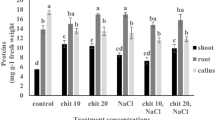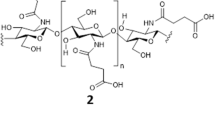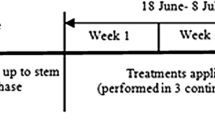Abstract
To determine the effects of carboxymethyl chitosan on plant growth and nutrient uptake, Prunus davidiana seedlings were treated with various concentrations of carboxymethyl chitosan. The biomass, physiological characteristics, and nutrient uptake of the treated P. davidiana seedlings were then examined. Compared with the control seedlings, the carboxymethyl chitosan-treated seedlings had a higher biomass and a greater abundance of photosynthetic pigments (i.e., chlorophyll a, chlorophyll b, total chlorophyll, and carotenoid), with the best concentration as 2 g/L carboxymethyl chitosan, which increased the shoot biomass and total chlorophyll content by 26.75% and 24.64%, respectively. Moreover, the application of carboxymethyl chitosan enhanced superoxide dismutase and catalase activities, increased the soluble protein content, and decreased the malondialdehyde and proline contents of the P. davidiana seedlings to some extent. Additionally, the carboxymethyl chitosan treatments decreased the total nitrogen content, but increased the total phosphorus and potassium contents in P. davidiana seedlings to some extent. The minimum of total nitrogen content and the maximum of total phosphorus and potassium contents in shoots of P. davidiana seedlings were the concentration of 2 g/L carboxymethyl chitosan, which was decreased by 12.96% and increased by 15.45% and 22.53%, respectively, compared with the control. Therefore, the application of a carboxymethyl chitosan solution may promote the growth, enhance the stress resistance, and alter the nutrient uptake of P. davidiana seedlings, especially at 2 g/L carboxymethyl chitosan.
Similar content being viewed by others
References
Bao SD (2000) Soil agrochemical analysis. China Agriculture Press, Beijing
Cheng XD, Sui YH, Zhang J (2015) Effects of salicylic acid on activities of antioxidant enzyme and osmolytes of pepper seedlings under nitrate stress. J Anhui Sci Technol Univ 29(6):56–60
Feng QX, Zhao XW, Chen ZZ, Wang MZ, Liu LX (2018) Research progress of chitosan and its application. Sci Technol Food Ind 39(21):333–336, 341
Gao F, Xie Y, Shen YQ, Lei Z, Wang X, Xia H, Liang D (2018) Exogenous melatonin for NaCl stress with antioxidant enzymes and osmotic substances of Aclinidia deliciosa seedlings. J Zhejiang A F Univ 35(2):291–297
Guan YJ, Hu J, Wang XJ, Shao CX (2009) Seed priming with chitosan improves maize germination and seedling growth in relation to physiological changes under low temperature stress. J Zhejiang Univ-Sc B 10(6):427–433
Hao ZB, Cang J, Xu Z (2004) Plant physiology experiment. Harbin Institute of Technology Press, Haibin
Hao LL, Wang XQ, Zhang XR, Zhu QZ (2014) Effect of chitosan on growth and drought resistance of wheat seedlings under drought stress. Resour Dev Mark 30(8):908–909, 1005
Hu JW, Liu H, Ma XM, Song T (2018) Antibacterial, inducing and promoting effects of chitosan and its application in agriculture. Jiangsu Agric Sci 46(15):1–5
Huang WC, Fan YB, Wang YC (2018) Low Temperature stress and maize seedlings: effect on antioxidant enzyme system and osmotic regulation. Chin Agric Sci Bull 34(24):6–12
Jabeen N, Ahmad R (2013) The activity of antioxidant enzymes in response to salt stress in safflower (Carthamus tinctorius L.) and sunflower (Helianthus annuus L.) seedlings raised from seed treated with chitosan. J Sci Food Agric 93:1699–1705
Jiang Y, Zhao Y, Sun QJ, Li ZW (2018) Application of plant growth regulators on plant growth and development. Heilongjiang Sci 9(24):4–7, 11
Jiao ZL, Li Y, Li JJ, Xu XY, Li H, Lu DQ, Wang JY (2012) Effects of exogenous chitosan on physiological characteristics of potato seedlings under drought stress and rehydration. Potato Res 55:293–301
Liu J, Liu YQ, Li J, Sun SX, Wang YQ (2017) Effects of alkali stress on Prunus davidiana (Carr.) leaf morphological structure and photosynthetic characteristics. Southwest China J Agric Sci 30(2):327–332
López ML, Peralta-Videa JR, Benitez T, Duarte-Gardea M, Gardea-Torresdey JL (2007) Effects of lead, EDTA, and IAA on nutrient uptake by Alfalfa plants. J Plant Nutr 30(8):1247–1261
Lu JN (2008) Research advance on the applications of chitosan in agricultural production. China Plant Prot 28(2):16–18
Ma ZX, Garrido-Maestu A, Jeong KC (2017) Application, mode of action, and in vivo activity of chitosan and its micro- and nanoparticles as antimicrobial agents: a review. Carbohydr Polym 176:257–265
Mo KM, Gan Y (2017) Effects of different concentrations of plant growth regulators on physiological indices of Cunninghamia lanceolata seedlings. J Green Sci Technol 9:89–91
Muley AB, Shingote PR, Patil AP, Dalvi SG, Suprasanna P (2019) Gamma radiation degradation of chitosan for application in growth promotion and induction of stress tolerance in potato (Solanum tuberosum L.). Carbohydr Polym 210:289–301
Park BK, Kim MM (2010) Applications of chitin and its derivatives in biological medicine. Int J Mol Sci 11(12):5152–5164
Rabêlo VM, Magalhães PC, Bressanin LA, Carvalho DT, dos Santos MH, Santos PRD, de Souza TC (2019) The foliar application of a mixture of semisynthetic chitosan derivatives induces tolerance to water deficit in maize, improving the antioxidant system and increasing photosynthesis and grain yield. Sci Rep 9(1):8164
Rahman M, Mukta JA, Sabir AA, Gupta DR, Mohi-Ud-Din M, Hasanuzzaman M, Miah MG, Rahman M, Islam MT (2018) Chitosan biopolymer promotes yield and stimulates accumulation of antioxidants in strawberry fruit. PLoS ONE 13(9):e0203769
Van SN, Minh HD, Anh DN (2013) Study on chitosan nanoparticles on biophysical characteristics and growth of Robusta coffee in green house. Biocatal Agric Biotechnol 2(4):289–294
Wang Z (2000) Plant physiology. China Agriculture Press, Beijing
Wang C, Zhang SH, Wang PF, Hou J, Qian J, Ao YH, Lu J, Li L (2011) Salicylic acid involved in the regulation of nutrient elements uptake and oxidative stress in Vallisneria natans (Lour.) Hara under Pb stress. Chemosphere 84:136–142
Yang F, Hu JJ, Wu HJ, Qian YR (2009) Chitosan enhances leaf membrane stability and antioxidant enzyme activities in apple seedlings under drought stress. Plant Growth Regul 58:131–136
Yu RZ, Yu XC, Wang GH (2003) Effect of chitin on the growth and physiological characteristics of cucumber seedling. Acta Agric Boreali-occident Sin 12(4):102–104
Yuan JR, Li BZ, Wu JS, Li X, Xiao HA (2012) Effects of plant growth regulators on yield, quality and nutrients absorption efficiency in water spinach. Chin Agric Sci Bull 28(22):282–286
Zhang JF, Li QM, Duan XF, Liu GQ, Peng ZD (2010) Effects of chitosan on seed germination and seedling growth of Zizphus acidojuba. J Beijing For Univ 32(6):146–150
Zhang CL, Liu FX, Wang ZX, Liu ZZ, Jiang L (2019) Study on ‘Xiacui’ grafting on different seedling peach rootstocks. Northern Fruits 4:9–12
Zhou YZ, Zhao X, Liang XH, Zheng DH, Cao TH (2018) Effects of plant growth regulators on photosynthesis and major physiological properties of maize seedlings under cold stress. Agric Sci J Yanbian Univ 40(1):1–7, 13
Acknowledgements
We thank Liwen Bianji, Edanz Editing China (www.liwenbianji.cn/ac) for editing the English text of a draft of this manuscript. This work was financially supported by the National Key Research and Development Plan of China (2018YFD0201400).
Author information
Authors and Affiliations
Contributions
DDX and HYL performed the experiments, analysed the data, and drafted the manuscript. LJL planted and managed the materials in the field. MAL, QXD and JW inoculated the seedlings and helped with sampling. XLL, HHD, DL and HX conceived the study, participated in its design and coordination, and helped draft the manuscript. All authors read and approved the final manuscript.
Corresponding author
Ethics declarations
Conflict of interest
The authors declare no competing interests, including financial and non-financial interests.
Additional information
Publisher's Note
Springer Nature remains neutral with regard to jurisdictional claims in published maps and institutional affiliations.
Rights and permissions
About this article
Cite this article
Xu, D., Li, H., Lin, L. et al. Effects of carboxymethyl chitosan on the growth and nutrient uptake in Prunus davidiana seedlings. Physiol Mol Biol Plants 26, 661–668 (2020). https://doi.org/10.1007/s12298-020-00791-5
Received:
Revised:
Accepted:
Published:
Issue Date:
DOI: https://doi.org/10.1007/s12298-020-00791-5




